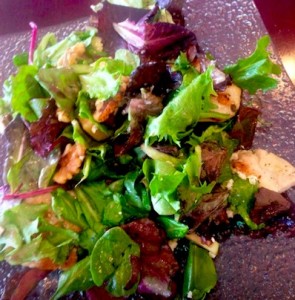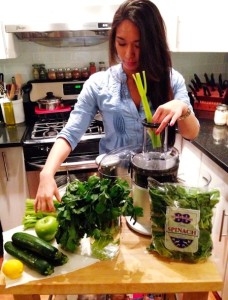What Social Media Won’t Tell You: Research First, Diet Second

Photo: U-Jin Lee
Some of the trending hashtags on Instagram, the popular mobile app, include: Skinny, detox, clean-eating, and dieting, which lead to pages filled with images of girls before and after dieting. There’s a thin model dressed in a slim, yellow blazer, casually sipping juice, above a photo of almonds, blueberries, and dried fruits in a bowl that has over 15,500 “likes.”
Over 150 million Instagram users nationwide can access the app’s diet profiles, but anyone can create an account that promotes their favorite regimen. Social media have become a dieting marketplace and a nightmare for experts who prefer their food regimens served with a side order of quantifiable evidence. And for all the noise on both sides, they don’t seem to be making a difference.
In the United States, 27.1 percent of adults were obese in 2013, the highest rate measured since Gallup and Healthways began tracking in 2008, an increase of nearly a full percentage point over the average rate of 26.2% found in 2012, according to a recent report by the Gallup and Healthways. The numbers are headed in the wrong direction, even as the national obsession with our appearance grows.
While up to one third of men and women in the U.S. are overweight, twice as many believe that they weigh more than they should, the National Center for Eating Disorders reports, a belief that is much more common in women than it is in men. An increasing number look for a solution online, which concerns psychology professor Robin Kanarek of the Friedman School of Nutrition at Tufts University, who worries about the popularity of restrictive fad diets.
“If you see that more and more people are doing these diets, of course this will only reinforce you to believe that this is the best way to lose weight,” she said. “But one of the greatest concerns of following dieting trends on social media is that people often do not do thorough research before going on these diets.”
“People are so focused on the physical appearances that they choose to ignore what’s going on physiologically inside their bodies,” she said. Kanarek believes in the time-tested weight-loss equation, eat less and do more, including cardio and weight-lifting – which may be responsible, but doesn’t seem as interesting to young dieters as some of its trendy competitors, like the paleo, all-liquid, or gluten-free regimens.
Julia Silva, a 22-year-old student at The College of New Jersey, finds nutritional guidance on Instagram. “I’m on Instagram all the time,” she said. “I follow ’FitnessBarbie,’ ‘FitGirls,’ ‘FitnessFood’—they’re my motivation!”
What she’s seen has led her to embrace a no-carb diet, an old standby that seems to be enjoying a resurgence in popularity. On a daily basis, she replaces the wrap in a wrap sandwich with lettuce, eats lots of green vegetables, has flourless pasta that is made out of zucchini, and replaces mashed potatoes with mashed cauliflower.
“I don’t buy anything that has carbs,” she said. It makes me overeat and doesn’t fill me up. It’s the fastest way that I gain weight.”
Cynthia Sha, a 24-year-old real estate salesperson, also finds inspiration on Instagram and was inspired to go the no-carb route after a week-long birthday celebration dessert binge. She sees a direct causal link between carbs and poor health.
“When I eat carbohydrates, I feel lethargic and I’m constantly yawning all the time,” she said. “But if I don’t eat carbs, I feel so much more energized because my body doesn’t have to work as hard to break down all those carbs.”
After four months without carbs, Sha saw improvement. “Mentally, I feel like I’m more awake and energized,” she said. “I feel so much more confident.” So she decided to add another diet on top of the no-carb regimen, once a month—the BluePrint juicing diet, which calls for a three-day cleanse, six bottles of fruit and vegetable juices per day. The company’s website also strongly recommends that consumers not ingest solid-foods while on the juicing diet, to give the digestive system a rest.
“I’m addicted to this diet,” Sha said, of the no-carb and monthly juice combination. “It’s crazy because now, I think about food all the time and I think about what I put in my body.”
That obsession is part of what worries Professor Kanarek – along with the fact that the juices Sha consumes add carbohydrates back into the young woman’s diet. While social media capture before-and-after, there isn’t much about the science, or lack of it.
“People don’t realize there’s carbs in salads, fruits, and vegetables, so really, they don’t know much about the low-carbohydrate diet before even starting it,” Professor Kanarek said.
She is also concerned that many dieters do not realize that they may not be getting sufficient nutrition and vitamins – that by focusing on results like the ones they see online, they’re ignoring the real question of what other consequences a diet may have.
One of the problems that can occur with a low-carb diet, according to Kanarek, is that the body can go into a state of ketosis, where it burns muscle for energy because there are not enough carbohydrates.
“With the Internet and apps giving us instant information, it’s almost gotten to the point where we’re becoming brainwashed with what we’re seeing,” said certified fitness trainer and wellness coach Pat Perretta.
Like Kanarek, Perretta preaches the doctrine of eat less and do more – and adds keeping a food log to the mix, to help track calories and consume less without eliminating chunks of the food pyramid.
“Eating is an unconscious habit so you need to write down what you ate during the day,” he said. ‘It’s important to see that reality.”
Experts recommend that avid Instagrammers research a diet, or at least check out the creator of the profile to see if his or her expertise is in nutrition or wellness. Some Instagram profiles focus on healthy alternatives rather than on extreme dieting, according Perretta, and the key is to make that distinction.
Tags: diet, fitness, Food, Instagram, juicing


Your Comments